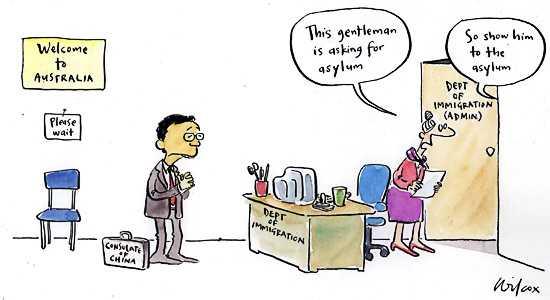June 07, 2005
Agamben: Australian reception#1
I have shown in my commentary below on Giorgio Agamben's difficult Homo Sacer that his work is very relevant to what is happening in Australia with respect to refugees, mandatory detention and the camps. It enables us to talk about the treatment of asylum seekers in a different language to that of human rights.

Cathy Wilcox.
The incident referred to in the cartoon is this. Chen Yonglin, a senior diplomat at China's Sydney consulate who was responsible for monitoring dissidents among the Chinese diaspora in NSW, had sought political asylum from Australia, and was rejected.
If we use Agamben's language we would rewrite the caption of the cartoon to say 'take him to the camp' and not 'show him to the asylum'. The camp is the biopolitics space of modernity.
How then is Girogio Agamben received in Australian academia?
Here is one account by Catherine Mills in Borderlands which addresses Agamben's Remnants of Auschwitz: The Witness and the Archive, which I have ordered but not read. This text is a consideration, and rethinking of, ethics in response to the camps--an ethics after Auschwitz based on the testimony of the survivors who bore witness to something unspeakable. Such an ethics is an ethics of witnessing.
Mills reads Agambe's text similarly to myself. She says that despite problems with the way Agamben structures his work, 'Agamben's insights nevertheless disclose and expose the assumptions often too readily accepted in contemporary debates and open a theoretical space for further elaboration.' In that space we find the latest issue of Contretemps devoted to the work of Agamben.I read those texts and found the academic language rather heavy going, without having first read Agamben. Hence my decision to read and work my way through Homo Sacer. I will return to them in latter posts.
An ethics of witnessing is useful as it makes for an opening into a new theoretical space of the political in Australia. Such an ethics has appeared in both the Bringing them Home and A Last Resort? reports by HREOC. The difference that should be noted is the nature of the witness: for Agemben it is not the testimony of the survivors of the Nazi concentration camps, but those who have not returned at all or have returned mute.
Agamben introduces the figure of the Muselmann, which Mills characterises thus:
"...the extreme figures of survival who no longer sustained the sensate characteristics of the living but who were not yet dead. The term 'Muselmann' refers to those in the camps who had reached such a state of physical decrepitude and existential disregard that 'one hesitates to call them living: one hesitates to call their death death'.... 'Muselmann' names the 'living corpses' that moved apparently inexorably toward death in the camps, beings who, through exhaustion and circumstance, had lost the capacity for living. They are the 'anonymous mass' that formed 'the backbone of the camps'"
This is the threshold between human and inhuman, life and death, and it is approached in the detentrion camps in Australia through the effects the camps have on the mental health of those incarcerated. Posted by Gary Sauer-Thompson at June 7, 2005 10:14 AM | TrackBack